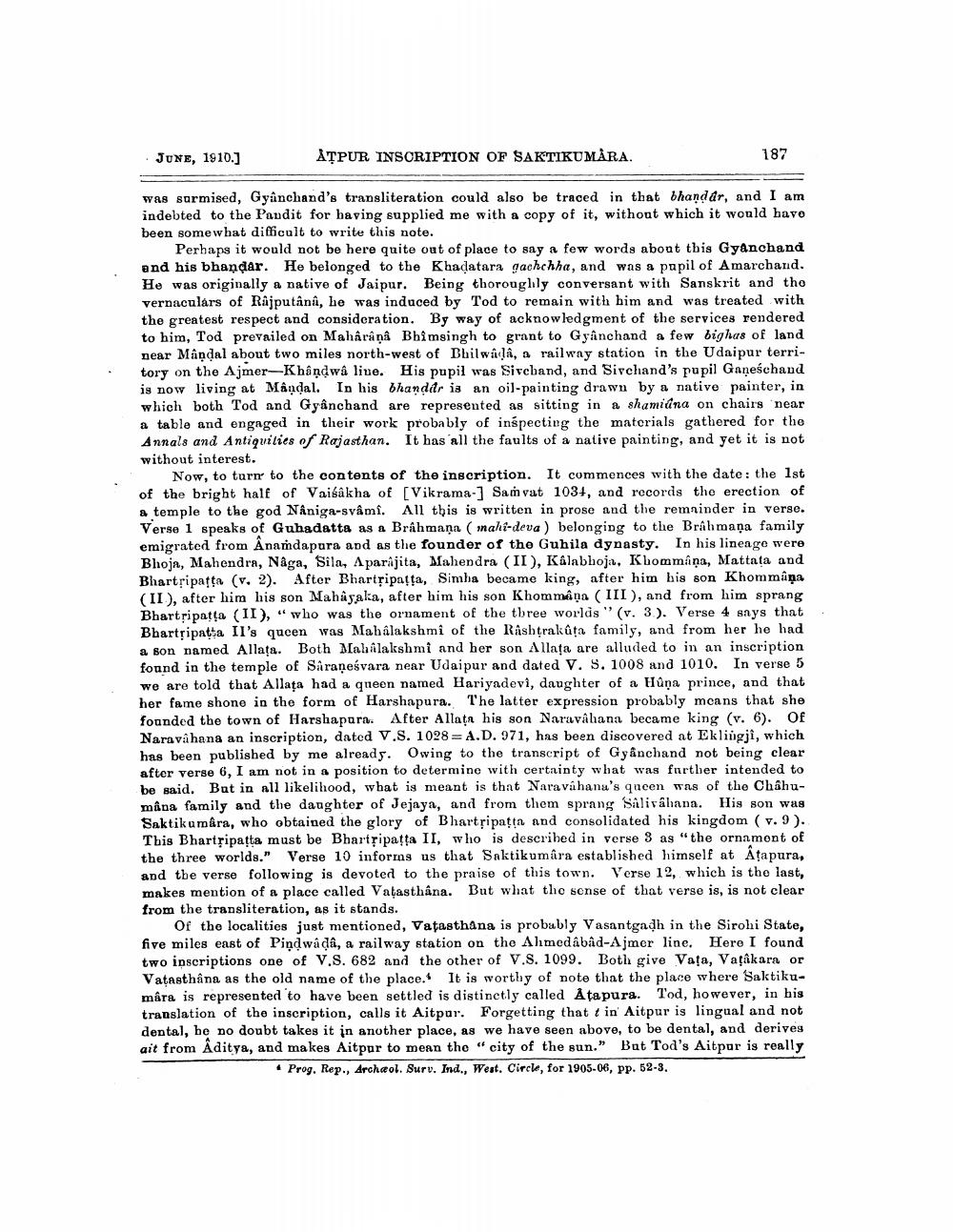________________
JUNE, 1910.]
ATPUR INSCRIPTION OF SAKTIKUMÅRA.
187
was surmised, Gyânchand's transliteration could also be traced in that bhandar, and I am indebted to the Pandit for having supplied me with a copy of it, without which it would havo been somewhat difficult to write this note.
Perhaps it would not be here quite out of place to say a few words abont tbis Gyanchand and his bhandar. He belonged to the Khadatara gachchha, and was a papil of Amarchand. He was originally a native of Jaipur. Being thoroughly conversant with Sanskrit and tho vernaculars of Rajputânî, he was induced by Tod to remain with him and was treated with the greatest respect and consideration. By way of acknowledgment of the services rendered to him, Tod prevailed on Mahârâņa Bhimsingh to grant to Gyanchand a few bighas of land near Mandal about two miles north-west of Bhilwada, a railway station in the Udaipur territory on the Ajmer-Khandwå live. His pupil was Sivchand, and Sivchand's pupil Gaņeśchand is now living at Mândal. In his bhandar is an oil-painting drawn by a native painter, in which both Tod and Gyânchand are represented as sitting in a shamiána on chairs near a table and engaged in their work probably of inspecting the materials gathered for the Annals and Antiquities of Rajasthan. It has all the faults of a native painting, and yet it is not without interest.
Now, to turn to the contents of the inscription. It commences with the date: the 1st of the bright half of Vaisakha of [Vikrama-] Sam vat 1031, and records the erection of a temple to the god Nâniga-svâmî. All this is written in prose and the remainder in verse. Verse 1 speaks of Guhadatta as a Brahmaņa (mahi-deva ) belonging to the Brâhmaņa family emigrated from Anandapura and as the founder of the Guhila dynasty. In his lineage were Bhoja, Mahendra, Någa, Sila, Aparajita, Mahendra (II), Kalabhoja, Khommaņa, Mattata and Bhartripatta (v. 2). After Bhartsipatta, Simba became king, after him his son Khommiņa (II), after him his son Mahayaka, after him his son Khommaņa (III), and from him sprang Bhartripatga (II), “who was the ornament of the three worlds" (v. 3). Verse 4 says that. Bhartripatta Il's queen was Mahalakshmi of the Rashtrakata family, and from her he had a son named Allața. Both Mahalakshmi and her son Allața are alluded to in an inscription found in the temple of Saraṇeśvara near Udaipur and dated V. S. 1008 and 1010. In verse 5 we are told that Allața had a queen named Hariyadevi, daughter of a Hûna prince, and that her fame shone in the form of Harshapura. The latter expression probably means that she founded the town of Harshapura. After Allata his son Naravahana became king (v. 6). Of Narava hana an inscription, dated V.S. 1028= A.D. 971, has been discovered at Eklingji, which has been published by me already. Owing to the transcript of Gyânchand not being clear after verse 6, I am not in a position to determine with certainty what was further intended to be said. But in all likelihood, what is meant is that Nara vahana's queen was of the Chahumâna family and the daughter of Jejaya, and from them sprang Salivahana. His son was Saktikumâra, who obtained the glory of Bhartripatta and consolidated his kingdom ( v. 9). This Bhartsipatta must be Bhartripatta II, who is described in verse 3 as "the ornamont of the three worlds." Verse 10 inforrns us that Saktikum ara established himself at Atapura, and the verse following is devoted to the praise of this town. Verse 12, which is the last, makes mention of a place called Vațasthana. But what the sense of that verse is, is not clear from the transliteration, as it stands.
Of the localities just mentioned, Vatasthana is probably Vasantgadh in the Sirohi State, five miles east of Piņdwada, a railway station on the Ahmedabad-Ajmer line. Here I found two inscriptions one of V.S. 682 and the other of V.S. 1099. Both give Vața, Vatakara or Vatasthana as the old name of the place. It is worthy of note that the place where Saktikumára is represented to have been settled is distinctly called Åtapura. Tod, however, in his translation of the inscription, calls it Aitpar. Forgetting that t in Aitpur is lingual and not dental, he no doubt takes it in another place, as we have seen above, to be dental, and derives ait from Aditya, and makes Aitpur to mean the " city of the sun." But Tod's Aitpur is really
• Prog. Rep., Archæol. Surv. Ind., West. Circle, for 1905-06, pp. 52-3.




